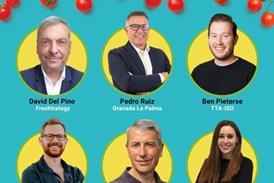Expect to see more plant-based, tech-enhanced, and even edible fresh produce packaging this year, as artificial intelligence continues to shape the business

As we head into 2025, the packaging industry is evolving rapidly, driven by sustainability, innovation, and efficiency. In the produce sector, this transformation is evident in the rise of biodegradable materials, smart packaging, and a growing focus on reducing plastic usage.
In 2024, global trends – particularly in Europe – pushed for bans or limits on plastic packaging for fresh produce, prompting the adoption of alternatives like compostable films and reusable containers. This shift, alongside advancements in automation and AI, has optimised designs, improved sustainability, and reduced waste.
These changes are also positioning the packaging industry to meet both environmental goals and consumer demands for more responsible solutions.
Key trends expected to shape the packaging sector in 2025 include:
1. Sustainable packaging solutions:
As sustainability remains a top priority, the produce industry is increasingly focusing on eco-friendly packaging solutions to meet consumer demand for less waste and more environmentally responsible practices.
In fact, packaging plays a key role in preserving the freshness and quality of fruits and vegetables during transport, but traditional materials, like plastic, contribute significantly to pollution and waste.
To address this, the industry is exploring a variety of sustainable packaging alternatives. Biodegradable and compostable options, such as PLA (polylactic acid), mushroom-based packaging, and cellulose films, are replacing traditional plastics. These materials break down naturally, reducing environmental impact while maintaining the freshness of produce during transit.
Materials like PLA, mushroom packaging, seaweed wraps, and cellulose films help reduce plastic waste and reliance on fossil fuels while supporting circular economies by decomposing without harmful residues.
However, challenges remain. Many biodegradable materials, such as PLA, require industrial composting, limiting their effectiveness in non-industrial settings. Additionally, their production can still be resource-intensive, and they may not offer the same durability or shelf-life protection as plastic.
Despite these issues, they represent a promising step toward more sustainable produce packaging. Expect widespread adoption as retailers and consumers demand more eco-friendly alternatives.
2. Minimalist and reduced packaging
Minimalist packaging is becoming a key strategy in the produce industry to reduce waste and environmental impact. By using fewer materials, such as reducing plastic layers and adopting lightweight, durable designs, companies can protect produce while cutting down on material usage. This trend meets consumer demand for more sustainable options and helps businesses comply with stricter environmental regulations.
Minimalist packaging also enhances shipping efficiency by reducing volume and weight, leading to lower transportation costs and emissions. Brands that embrace eco-friendly packaging can improve their reputation, attract sustainability-conscious consumers, and potentially reduce material and shipping expenses.
While the challenge remains to ensure adequate protection for delicate produce, innovations in sustainable packaging materials are making it possible to reduce waste without compromising quality. This shift toward minimalist designs helps companies align with both environmental goals and consumer expectations.
3. Edible packaging
In 2025, edible packaging is expected to see significant growth, particularly in the produce industry. Made from plant-based materials like seaweed, starch, or rice, edible films can be consumed along with the produce, eliminating packaging waste entirely. This innovative solution not only reduces environmental impact but also enhances the consumer experience by integrating the packaging into the product itself, making it part of the food rather than waste.
Edible packaging also holds potential for extending the shelf life of fresh produce by providing an additional protective layer that helps reduce spoilage and moisture loss. This could be a game-changer in maintaining freshness without relying on traditional plastic wraps.
However, challenges remain, including scaling production, ensuring cost-effectiveness, and developing materials that are durable enough for transportation while still being edible. As the technology matures, edible packaging could play a central role in creating a more sustainable, waste-free future for the produce industry, aligning with broader goals of a circular economy.
4. Smart packaging for freshness and traceability
Smart packaging is revolutionising the way produce is tracked, monitored, and consumed. Technologies like RFID (Radio Frequency Identification) tags, QR codes, and freshness sensors are enabling real-time tracking of produce throughout the supply chain. These innovations help ensure that produce stays fresh, reducing spoilage and food waste.
Freshness sensors, for example, can detect temperature and humidity changes, alerting suppliers or retailers to any conditions that might compromise product quality.
Smart packaging also provides transparency, allowing consumers to easily access information about a product’s origin, sustainability practices, and nutritional content. By scanning a QR code, customers can learn about the farm where the produce was grown, the environmental impact of its packaging, and the benefits it offers. This level of transparency builds customer trust and encourages more informed purchasing decisions. As demand for traceability and sustainability increases, smart packaging will play a key role in enhancing both the consumer experience and the efficiency of the produce supply chain.
5. Plant-based and natural fibre packaging
Plant-based materials like bamboo, hemp, and palm leaves are becoming increasingly popular in the produce packaging industry due to their strength, biodegradability, and sustainability. These natural fibres are ideal for packaging bulk produce such as potatoes, onions, and bananas, as they provide effective protection during transportation and storage while reducing environmental impact. Unlike plastic, which can take hundreds of years to break down, plant-based materials decompose naturally, leaving minimal waste behind.
These materials are also renewable resources, meaning they can be replenished over time, unlike petroleum-based plastics that rely on non-renewable fossil fuels. As a result, they support a more sustainable production model and contribute to a circular economy, where resources are reused, recycled, or biodegraded instead of accumulating as waste. In addition, plant-based packaging materials require less energy to produce compared to traditional plastics, further reducing their environmental footprint. By replacing plastic with natural fibres, the produce industry can significantly cut down on waste and resource consumption, promoting a more eco-friendly approach to packaging.
6. Recyclable and reusable packaging
Recyclable and reusable packaging is set to become a cornerstone of sustainability in the produce industry, significantly reducing its environmental footprint. Packaging made from recycled PET (rPET) and other recyclable materials provides an effective solution to reduce the reliance on single-use plastics, which are a major source of pollution.
rPET, made from post-consumer plastic waste, not only helps divert plastics from landfills but also requires less energy to produce than virgin plastic, making it a more environmentally friendly alternative.
In addition to recyclable materials, reusable containers are increasingly being adopted for bulk produce sales. Items such as mesh bags, sturdy crates, and reusable plastic or fabric containers encourage consumers to either return packaging for reuse or bring their own containers when shopping.
This shift reduces the need for single-use packaging, significantly lowering overall waste generation. Retailers and producers are also offering incentives to customers who choose reusable options, further promoting sustainable behaviour.
By encouraging recycling and reuse, the produce industry can minimise its contribution to plastic waste and support a more sustainable, circular economy, aligning with growing consumer demand for environmentally responsible products.
7. Advanced packaging automation and AI
This year, the integration of artificial intelligence (AI) and automation in packaging production will dramatically enhance efficiency and sustainability within the produce industry. AI-driven systems can optimise packaging designs, ensuring that materials are used more effectively, while reducing waste and resource consumption. Automated production lines will speed up processes, streamline operations, and minimise human error, leading to more precise and consistent packaging.
These technologies will also improve supply chain management, allowing for better tracking of packaging materials and finished goods, which can reduce delays and inefficiencies. AI systems enable real-time data analysis, allowing companies to predict demand, adjust packaging accordingly, and ensure that products are packaged in the most sustainable way possible.






